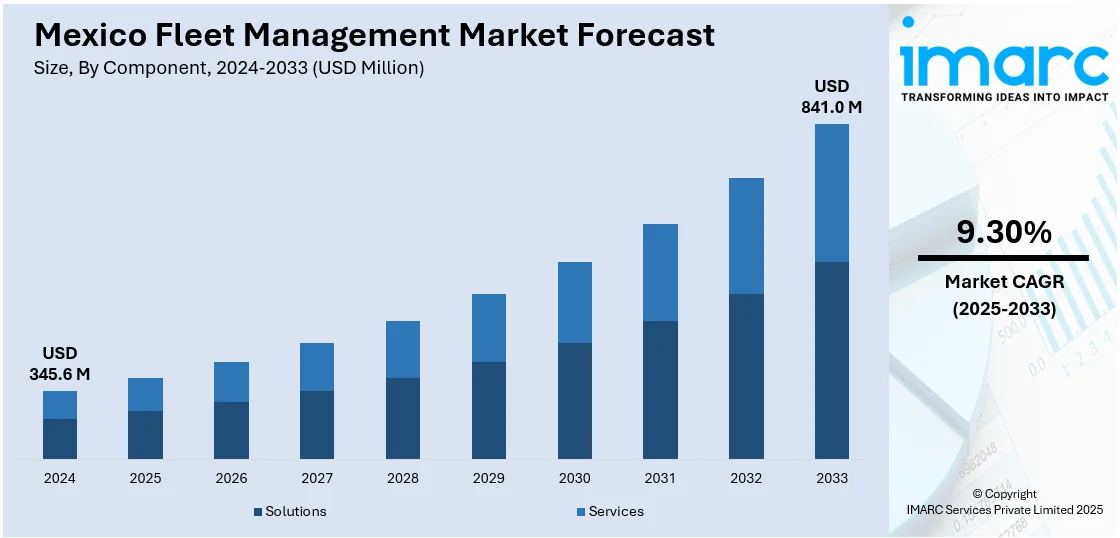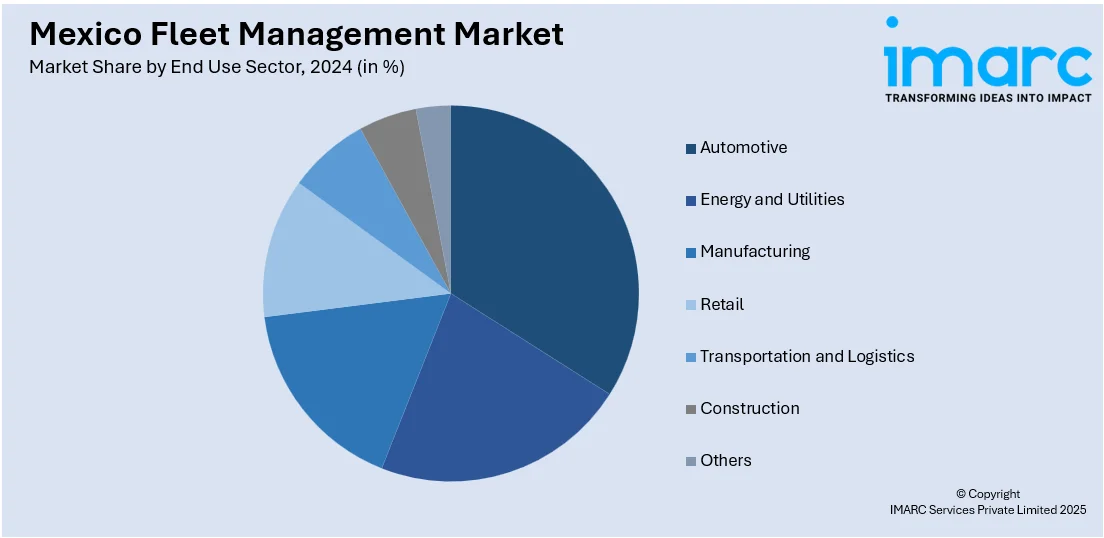
Mexico Fleet Management Market Size, Share, Trends and Forecast by Component, Vehicle Type, Technology, Deployment Type, End Use Sector, and Region, 2025-2033
Mexico Fleet Management Market Overview:
The Mexico fleet management market size reached USD 345.6 Million in 2024. Looking forward, IMARC Group expects the market to reach USD 841.0 Million by 2033, exhibiting a growth rate (CAGR) of 9.30% during 2025-2033. The increasing demand for operational efficiency, the need for cost reduction, stringent government regulations on emissions and safety, and advancements in telematics technology are propelling the market growth. Additionally, the rise in e-commerce, environmental sustainability concerns encourage, growing transportation and logistics industries, the shift towards digital platforms, improved fuel management, real-time vehicle tracking, data-driven decision-making, and enhanced safety standards are factors boosting the Mexico fleet management market share.
|
Report Attribute
|
Key Statistics
|
|---|---|
|
Base Year
|
2024 |
|
Forecast Years
|
2025-2033
|
|
Historical Years
|
2019-2024
|
| Market Size in 2024 | USD 345.6 Million |
| Market Forecast in 2033 | USD 841.0 Million |
| Market Growth Rate 2025-2033 | 9.30% |
Mexico Fleet Management Market Trends:
Increasing Demand for Operational Efficiency and Cost Reduction
The growing demand for operational efficiency and cost reduction is driving the Mexico fleet management market growth. Businesses are looking for opportunities to optimize operations and decrease costs, which is particularly high in fleet-based industries like logistics, transportation, and delivery. Fleet management systems, which includes global positioning system (GPS) tracking, real-time vehicle diagnostics and route optimization, enable companies to track vehicle performance and cut fuel use. They also contribute to the reduction of downtime of collected vehicles by estimating maintenance requirements and maximizing vehicle availability. Amid soaring fuel costs and higher operating expenses, corporates are concentrating on optimizing use of fleets, routes and avoiding redundant expenditures, which is facilitating the market growth. In addition to this, the use of fleet management technologies allows businesses to collect data in real time, which leads to operational efficiency and cost savings, further propelling the market growth.

Stringent Government Regulations on Emissions and Safety Standards
Government regulations on emissions and safety standards are some of the factors driving the adoption of fleet management systems in Mexico. In line with this, federal and local governments have enacted more stringent environmental policies with the clear objective of shrinking the carbon footprint in transportation. Fleet management systems keep operators compliant by tracking live vehicle performance and emissions, providing advice on maintaining the emission levels. Furthermore, they allow fleet operators to better plan for maintenance, thereby maintaining compliance with mandated safety and environmental standards. As the government continues to shift its focus towards a greener responsible fleet industry, businesses are using fleet management as a means of controlling costs, reducing their carbon footprint, and promoting safer working practices, which is supporting the market growth.
Rise in E-Commerce and the Need for Efficient Logistics
The surge in e-commerce has significantly boosted the demand for efficient logistics and fleet management in Mexico. As online shopping continues to grow in popularity, businesses are under increasing pressure to offer faster and more reliable delivery services. Efficient fleet management plays a crucial role in achieving this goal by helping companies optimize routes, reduce delivery times, and track inventory in real time. With the rise of e-commerce giants like Amazon and Mercado Libre, there is a greater emphasis on last-mile delivery solutions, and fleet management technology is key in ensuring that deliveries are timely and cost-effective. By integrating route optimization, real-time vehicle tracking, and automated scheduling, businesses can enhance their logistics operations to meet customer expectations. Additionally, fleet management systems provide valuable data on customer demand patterns, enabling businesses to adjust their operations dynamically.
Mexico Fleet Management Market Segmentation:
IMARC Group provides an analysis of the key trends in each segment of the market, along with forecasts at the country and regional levels for 2025-2033. Our report has categorized the market based on component, vehicle type, technology, deployment type, and end use sector.
Component Insights:
- Solutions
- Fleet Telematics
- Driver Information Management
- Vehicle Maintenance
- Safety and Compliance Management
- Others
- Services
- Installation and Integration Services
- After-Sales Support Services
- Consulting Services
The report has provided a detailed breakup and analysis of the market based on the components. This includes solutions (fleet telematics, driver information management, vehicle maintenance, safety and compliance management, others) and services (installation and integration services, after-sales support services, consulting services).
Vehicle Type Insights:
- Commercial Vehicles
- Passenger Cars
- Aircrafts
- Watercrafts
A detailed breakup and analysis of the market based on vehicle type is provided, including commercial vehicles, passenger cars, aircrafts, and watercrafts.
Technology Insights:
- GNSS
- Cellular Systems
The report has provided a breakdown of the market based on technology, focusing on GNSS and cellular systems.
Deployment Type Insights:
- Cloud-based
- On-premises
- Hybrid
The report includes a detailed analysis of the market based on deployment type, including cloud-based, on-premises, and hybrid.
End Use Sector Insights:

- Automotive
- Energy and Utilities
- Manufacturing
- Retail
- Transportation and Logistics
- Construction
- Others
The report also covers a detailed analysis of the market based on end use sector such as automotive, energy and utilities, manufacturing, retail, transportation and logistics, construction, and others.
Regional Insights:
- Northern Mexico
- Central Mexico
- Southern Mexico
- Others
The report provides a comprehensive analysis of the regional markets, including Northern Mexico, Central Mexico, Southern Mexico, and other.
Competitive Landscape:
The market research report has also provided a comprehensive analysis of the competitive landscape. Competitive analysis such as market structure, key player positioning, top winning strategies, competitive dashboard, and company evaluation quadrant has been covered in the report. Also, detailed profiles of all major companies have been provided.
Mexico Fleet Management Market News:
- In May 2024, Motive announced the expansion of its AI-powered safety and fleet management solutions into Mexico. The company established a regional office in Mexico City to support local operations and meet growing demand, marking a strategic move to strengthen its presence in Latin America's evolving transportation technology market.
- In September 2024, Element Fleet Management launched new services, including Variable Fleet and Extended Warranty programs. The initiative aims to address the evolving requirements of fleet operators in Mexico, offering more flexible and comprehensive solutions to enhance operational efficiency and vehicle lifecycle management in a competitive market.
Mexico Fleet Management Market Report Coverage:
| Report Features | Details |
|---|---|
| Base Year of the Analysis | 2024 |
| Historical Period | 2019-2024 |
| Forecast Period | 2025-2033 |
| Units | Million USD |
| Scope of the Report |
Exploration of Historical Trends and Market Outlook, Industry Catalysts and Challenges, Segment-Wise Historical and Future Market Assessment:
|
| Components Covered |
|
| Vehicle Types Covered | Commercial Vehicles, Passenger Cars, Aircrafts, Watercrafts |
| Technologies Covered | GNSS, Cellular Systems |
| Deployment Types Covered | Cloud-based, On-premises, Hybrid |
| End Use Sectors Covered | Automotive, Energy and Utilities, Manufacturing, Retail, Transportation and Logistics, Construction, Others |
| Regions Covered | Northern Mexico, Central Mexico, Southern Mexico, Others |
| Customization Scope | 10% Free Customization |
| Post-Sale Analyst Support | 10-12 Weeks |
| Delivery Format | PDF and Excel through Email (We can also provide the editable version of the report in PPT/Word format on special request) |
Key Questions Answered in This Report:
- How has the Mexico fleet management market performed so far and how will it perform in the coming years?
- What is the breakup of the Mexico fleet management market on the basis of component?
- What is the breakup of the Mexico fleet management market on the basis of vehicle type?
- What is the breakup of the Mexico fleet management market on the basis of technology?
- What is the breakup of the Mexico fleet management market on the basis of deployment type?
- What is the breakup of the Mexico fleet management market on the basis of end use sector?
- What is the breakup of the Mexico fleet management market on the basis of region?
- What are the various stages in the value chain of the Mexico fleet management market?
- What are the key driving factors and challenges in the Mexico fleet management market?
- What is the structure of the Mexico fleet management market and who are the key players?
- What is the degree of competition in the Mexico fleet management market?
Key Benefits for Stakeholders:
- IMARC’s industry report offers a comprehensive quantitative analysis of various market segments, historical and current market trends, market forecasts, and dynamics of the Mexico fleet management market from 2019-2033.
- The research report provides the latest information on the market drivers, challenges, and opportunities in the Mexico fleet management market.
- Porter's five forces analysis assist stakeholders in assessing the impact of new entrants, competitive rivalry, supplier power, buyer power, and the threat of substitution. It helps stakeholders to analyze the level of competition within the Mexico fleet management industry and its attractiveness.
- Competitive landscape allows stakeholders to understand their competitive environment and provides an insight into the current positions of key players in the market.
Need more help?
- Speak to our experienced analysts for insights on the current market scenarios.
- Include additional segments and countries to customize the report as per your requirement.
- Gain an unparalleled competitive advantage in your domain by understanding how to utilize the report and positively impacting your operations and revenue.
- For further assistance, please connect with our analysts.
 Request Customization
Request Customization
 Speak to an Analyst
Speak to an Analyst
 Request Brochure
Request Brochure
 Inquire Before Buying
Inquire Before Buying




.webp)




.webp)












